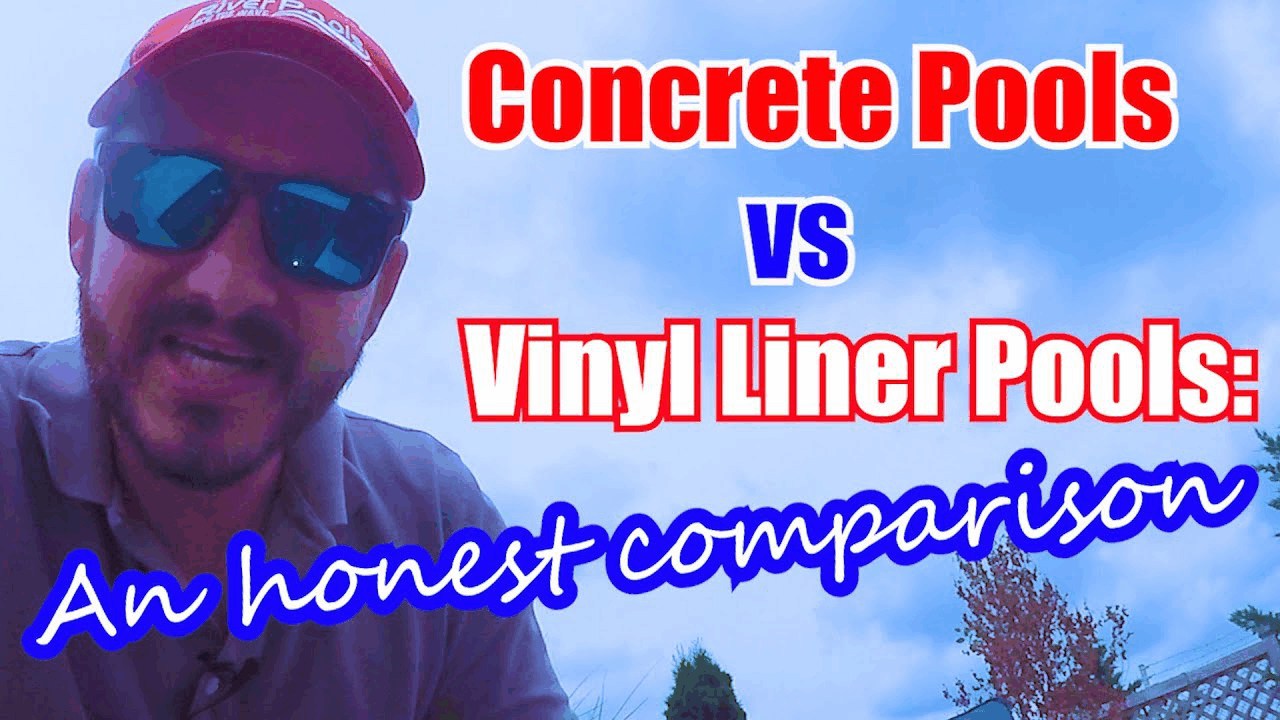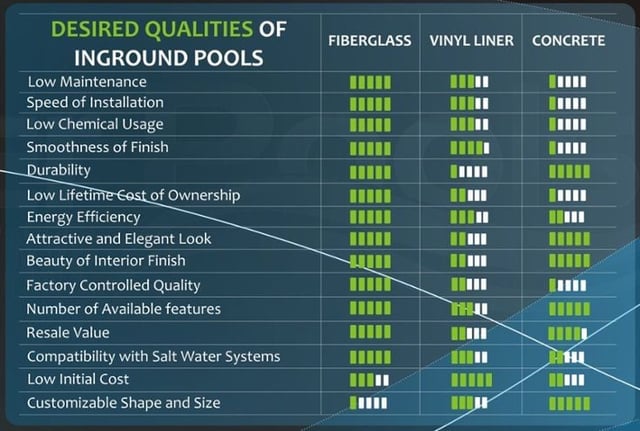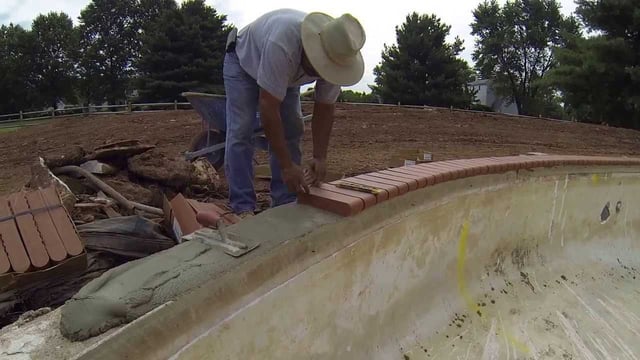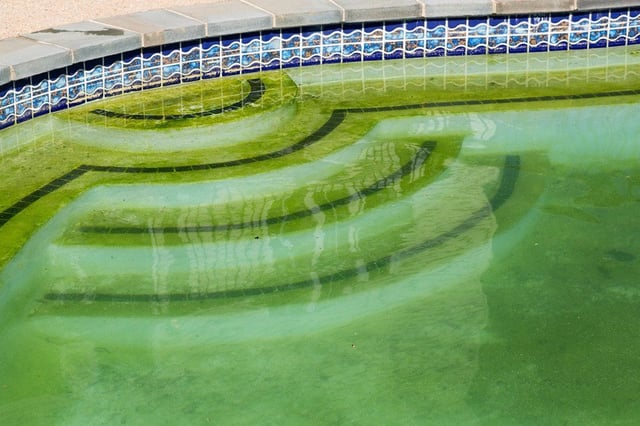Concrete Pools vs. Vinyl Liner Pools: An Honest Comparison
October 27th, 2017
8 min read
By Holly Jender

Even though we’re one of the country’s leading fiberglass pool specialists, we’re still familiar with concrete and vinyl liner pools and understand that they have a place in the market. We appreciate their value and recognize that people want to learn about all types of pools.
We’re here to help you learn everything you need to know about buying the perfect pool for you and your family.

In this article, we'll cover the pros and cons of these two types of pools in the following areas:
- Customization
- Installation time
- Cost (initial and lifetime)
- Interior surface texture
- Durability
- Hands-on maintenance
- Algae
- Chemical usage
- Energy usage

Is a concrete or vinyl liner pool better for me?
Concrete pools cost $65,000 or more and require expensive long-term maintenance. They can be any shape but take 3–6 months to install. Vinyl liner pools cost $45,000 or more and need the liner replaced every 5–9 years. They take 3–6 weeks to install but tend to look cheap.
Customization
Concrete
Concrete pools are perfect if you want an extremely deep or large pool. It’s also a huge bonus if you’re looking for a pool with a fun shape or custom features such as special tanning ledges (also available in fiberglass).
Vinyl Liner
Most vinyl liner pools are rectangular, but it is possible to customize the shape, size, and depth of the pool. Custom shapes do cost more, but still typically less than your average fiberglass or concrete pool of similar size.
Conclusion
Both can be customized, but it’s more expensive for a vinyl liner pool, and a concrete pool has more available features. Winner: Concrete
Installation time
Concrete
Concrete pools can take 3–6 months or longer to finish, and they're typically installed using the gunite process, which is why you'll often see concrete pools referred to as "gunite pools." It won’t cut into your pool time if you start during winter or while you’re out of town, but it still isn’t pretty to look at. Worse, if you start in late spring, it’ll look gross and postpone your summer swimming.

Vinyl Liner
Builders can install a vinyl liner pool in 4–8 weeks. Even if you start in June, you could still spend most of the summer enjoying the pool.
Conclusion
A concrete pool would take your entire summer to install, and a vinyl liner pool only a month. Winner: Vinyl Liner
Cost (initial and lifetime)
Concrete
For most people, there is no DIY option for concrete pools. Ready-made gunite pool projects typically cost between 85,000 and 200,000 upfront.
In addition to this significant upfront cost, concrete pool maintenance costs over $25,000 every ten years thanks to regular acid washes, replastering, and high chemical and electricity usage.
Vinyl Liner
In the initial purchase, vinyl liner pools generally cost from 65,000–125,000, which is at least $10,000 less than similar fiberglass or concrete pools.
Someone who wants a DIY vinyl liner pool may spend under $20,000. Base vinyl liner packages from most pool builders typically cost $45,000–$80,000, while ready-to-use vinyl liner packages will typically cost $35,000–$55,000.
The pool will also use less electricity and fewer chemicals overall than a concrete pool of the same size, which reduces the lifetime cost.
The vinyl liner needs to be replaced every 5–9 years, and this costs about $4,000–$4,500 including the labor and materials.
How this adds up: the low initial cost of the pool could be offset within the first ten years after construction, and over the entire lifetime of the pool, it will cost thousands more than a fiberglass pool.
On top of the initial and lifetime costs, you’ll need to read your whole liner warranty. The warranty is typically stated as twenty years or so but will often fine-print these qualifiers:
- The warranty only covers the seams of the liner, where the sections of material are fused together.
- The warranty does not cover any labor, water, or other expenses.
- The warranty is prorated—some credit toward a new liner during the first two or three years, but very little after that.
Conclusion
Despite a vinyl liner pool’s warranty issues and liner replacements, a concrete pool costs more both upfront and in overall lifetime maintenance. Winner: Vinyl Liner
Interior surface texture
Concrete
The rough interior of a concrete pool scrapes skin. Most kids who play in concrete pools on a regular basis have to wear water shoes to protect their feet from becoming sore and blistered.
The most common finish is plaster. You can upgrade to exposed aggregate like Pebble Tec, which is still rough because it’s bumpy. If you want a smooth feel, you may want to look into a polished aggregate finish—it’s smooth but still shows the pretty stones or glass it’s made of.
Vinyl Liner
The vinyl liner is smooth other than the ridge where one piece meets another. As long as you take care of it (repair or replace any holes), you don’t need to worry about scrapes.
Conclusion
Smooth vinyl liner is kinder to your feet than rough plaster or even fancy Pebble Tec. Winner: Vinyl Liner
Durability
Concrete
The structure of a concrete pool—that is, the actual concrete—is incredibly durable.
The finish of a concrete pool—the plaster—is strong as well. You don’t have to worry about damage to the pool interior from sharp objects or dog claws, unlike vinyl liner pools.
However, the concrete pool finish (while tough) does not last as long as the gelcoat surface of a fiberglass pool. You need to replaster the pool every 10-15 years, including replacing the waterline tile.
As mentioned earlier, salt and concrete don't mix. The dissolved salt in the pool water will shorten the life expectancy of the interior finish of a concrete pool, thus requiring more frequent refinishing.
Vinyl Liner
Vinyl liners for inground pools are usually 20, 27, 28, or 30 mils thick—less than a millimeter. It’s easy for dog claws or a broken tree branch to puncture or rip the liner. Thicker vinyl liners, when installed correctly, provide extra protection against potential damage.
Still, the liner doesn’t last long overall. Even outside of major tears and holes, it needs to be replaced every 5-9 years.
On top of that, metal wall panels can corrode to the point of disintegrating, and polymer wall panels can become brittle and break.

Conclusion
Vinyl liners can be punctured easily; wall panels can corrode or split. Plaster needs follow-up maintenance but the concrete itself will survive the apocalypse. Winner: Concrete
Hands-on maintenance
Concrete
Algae easily embeds in the porous concrete and is extremely tough to remove. Concrete pool builders recommend brushing the entire surface of the pool with a steel brush at least once a week to remove any algae on the surface.
You also have to check and balance the water chemistry every week so your pool doesn’t start looking radioactive. (This is required for every pool type.)
Issues can also come up with the pool surface itself. Plaster stains, cracks, flakes, and wears away with time. This means acid washing the pool every 3–5 years, which you may choose to do yourself, but the vast majority of concrete pool owners pay a pro. You'll also have to hire a professional to refinish the plaster every 10-15 years.
Vinyl Liner
Wrinkles in your vinyl liner are only a cosmetic issue, but many people prefer to smooth them out, which takes significant time and effort.
Divots and dents are usually cosmetic as well, but a bump due to a rock or pebble could lead to a tear in the liner. For these issues, you have to drain the pool and remove the liner for repairs.
Like with concrete pools, you need to test and maintain the water chemistry.
When you replace the liner every 5–9 years, you can do it yourself, but we recommend hiring a professional. It’s not worth your blood, sweat, and tears, in my opinion.
Conclusion
Vinyl liners need to be repaired and replaced, but concrete has more issues overall. Winner: Vinyl Liner
Algae

Concrete
Plaster (your interior finish unless you splurge on tile) is extremely porous, which puts out the welcome mat for your friendly neighborhood algae—and like an unwanted houseguest, algae is difficult to remove once it’s moved in.
Vinyl Liner
The surface of a vinyl liner is relatively non-porous. However, algae can make its way into submerged areas that don’t circulate water, like the seams around the pool steps. Gross.
Conclusion
Algae can grow on either pool type, but it’s less frequent and less pervasive on a vinyl liner. Winner: Vinyl Liner
Chemicals and electrical energy
Concrete
Water chemistry is a related issue with concrete pools. Because algae embeds into the surface, you’ll use more chemicals to reach and destroy it. This requires more time and money to maintain the pool.
Your pump/filter system has to provide the heavy circulation and filtration to keep your pool clean. This can add as much as $800 to your yearly energy bill, even outside of repair costs if the system breaks.
Also, concrete is alkaline-based, which constantly increases the pH of the pool water. You have to add acid regularly to keep it in balance.
Vinyl Liner
The vinyl liner doesn’t affect the water chemistry as badly as plaster and concrete because it doesn't leach alkalinity into the water—so you use less time and money to keep the chemistry in balance.
You do still need to regularly measure and maintain your vinyl liner pool’s alkalinity, pH, calcium hardness, and chlorine levels.
A vinyl liner pool’s pump/filter system requires less energy than a concrete pool’s because vinyl pools are not predisposed to algae growth. It’s actually closer to a fiberglass pool’s energy bill.
Conclusion
Either way, you have to labor to maintain water chemistry, but concrete pools make it harder for you. Winner: Vinyl Liner
Which should I choose?
There isn’t really a universal “winner” in the end. These are just the aspects you’ll want to consider when you’re deciding on a pool for you and your family. For some people, aesthetics matter more than costs. For others, maintenance needs to be minimal. Only you know what your pool priorities are.
If you’re not quite satisfied with the pro/con balance of either pool type, you may want to look into fiberglass pools as a third alternative.
Unlike concrete pools, fiberglass pools are installed quickly (over a few weeks instead of months), require little maintenance, and cost significantly less over the lifetime of the pool. Unlike vinyl liner pools, fiberglass pools look lovely, can last a long time, and can be customized with cool features.
Concrete Pools are usually a good fit for those who:
- Have a budget of $65,000 or more
- Need a custom shape or depth, or can't find a fiberglass pool they like
- Don't mind spending a significant amount of their spare time and/or money maintaining the pool
- Can invest tens of thousands of dollars to keep the pool in working order
Vinyl Liner Pools typically fit those who:
- Have a budget of $45,000–$80,000
- Will only live in the home for two or three years (and can avoid the first liner replacement)
- Want the biggest pool for the cheapest price
Fiberglass Swimming Pools are usually good for those who:
- Have a budget of $55,000 or more
- Can find a fiberglass swimming pool design that meets their needs
- Want low maintenance
- Want a pool with low long-term costs
- Want a quick, easy installation
If you want to learn more about how fiberglass pools compare to concrete and vinyl liner pools, you can also read this article briefly comparing the three types or download our free ebook below.
At River Pools, we manufacture world-class fiberglass swimming pools for installation across North America. Take a look at our catalog of pool models to see if one of our fiberglass pools is right for you. We have sizes for small to large backyards and designs with built-in benches, tanning ledges, and spas.
Wondering how much your fiberglass pool will cost? Contact us today to request pricing, and in the meantime, try out our fiberglass pool pricing calculator tool below for a fast estimate:

Want to see about how much that cost will be with all your favorite pool accessories?
Use our Design and Price Tool to walk through your options and approximate price!
As always, if you have any questions, feel free to leave them in the comments below.
Up Next:
What Type of Inground Pool Is Best for Me?
A Massive Review of Concrete Swimming Pools: Costs, Maintenance, Longevity, and More
How Long Do Vinyl Liner Pools Last?
Editor's note: This article was originally written by Holly Jender and was updated on August 7, 2024, with current information. River Pools is a brand of inground fiberglass pools produced in a manufacturing facility in Fortville, IN. While our expertise is in manufacturing fiberglass pools, we have access to a network of installers with expertise relating to project design, installation, and pool service. We often tap into this knowledge base and share information freely with homeowners, just like you, considering installing a swimming pool in your backyard.


